she/her ✨queer ✨just a little side blog for hoarding worldbuilding tips and writing advice (and maybe for getting my own content out into the world)
Don't wanna be here? Send us removal request.
Text
I've already said that my number one piece of writing advice is to read.
But my number two piece of advice is this: be deliberate.
Honestly this would fix so many pieces of bad writing advice. Don't forbid people from doing something, tell them to be conscious and deliberate about it. This could help stop people from falling into common mistakes without limiting their creativity. Black and white imperatives may stop a few annoying beginner habits, but ultimately they will restrict artistic expression.
Instead of "don't use epithets": "Know the effect epithets have and be deliberate about using them." Because yes, beginners often misuse them, but they can be useful when a character's name isn't known or when you want to reduce them to a particular trait they have.
Instead of "don't use 'said'" or "just use 'said'": "Be deliberate about your use of dialogue tags." Because sometimes you'll want "said" which fades into the background nicely, but sometimes you will need a more descriptive alternative to convey what a character is doing.
Instead of "don't use passive voice": "Be deliberate about when you use passive voice." Because using it when it's not needed can detract from your writing, but sometimes it can be useful to change the emphasis of a sentence or to portray a particular state of mind.
Instead of blindly following or ignorantly neglecting the rules of writing, familiarize yourself with them and their consequences so you can choose when and if breaking them would serve what you're trying to get across.
Your writing is yours. Take control of it.
It probably sounds like I'm preaching to the choir here because most of my mutuals are already great writers. But I'm hoping this will make it to the right people.
20K notes
·
View notes
Text
5 Ways to Actually Get Writing Done Without Selling Your Soul (or Crying into Your Keyboard… Again)
» Set Specific Goals
Sitting down with the vague idea of “I’m gonna write something” is a trap. It’s like walking into a grocery store without a list—you’ll leave with five snacks, zero dinner, and a sense of moral failure. Set a goal. A real one. Like...
“I’m going to write 500 words.”
“I’m going to finally fix that scene where my MC argues like a confused raccoon.”
“I will name the horse in chapter 3 and stop calling it ‘Equine Placeholder.’”
Specific = focus. And when your brain knows the mission, it’s much less likely to yeet you into Instagram for 45 minutes.
» Make Your Writing Cave Cozy (But Not Too Cozy, You’re Still Supposed to Be Working)
You don’t need a Pinterest-worthy office to write, you just need a space where your brain doesn’t go, “Ah yes, this is where we rot.” That means:
Get rid of the chaos pile on your desk.
Turn off your phone notifications (no, you do not need to reply to that meme right now).
Put on music if it helps—lo-fi beats, rain sounds, dungeon ambiance, whatever makes your creative brain purr.
And listen, if your writing setup is literally “half my bed, one sad candle, and a playlist titled ‘angst in the moonlight’”—same. Make it work.
» Trick Yourself Into a Routine (Because Discipline is a Scam and We're Just Goblins With Deadlines)
Look, “routine” sounds boring and adult, but hear me out: it doesn’t have to be rigid. You don’t need to write at 5am with green juice in hand like a productivity cultist. You just need consistency.
Write after you brush your teeth.
Write before bed with your laptop balancing on your stomach like a raccoon with a diary.
Write for ten minutes during lunch, just to prove to yourself you’re still a writer.
The goal is to make writing so normal, your brain goes, “Oh, this again. I guess we’re doing this.” Momentum is magic.
» Use Productivity Hacks (Or: Outsmart Your Own Gremlin Brain)
Your brain? It’s crafty. It will try to distract you with snacks, existential dread, and seventeen Wikipedia tabs. So: outwit it.
Try the Pomodoro Technique:
25 minutes of writing.
5 minutes of pretending to stretch but actually scrolling.
Repeat until your story is slightly less of a hot mess.
Or time block. Or sprint with a friend. Or lie to yourself and say you’ll just write for five minutes—then trick yourself into staying because now you’re in the zone and your villain is being so deliciously cruel.
Whatever works. Bribe your brain. No shame here.
» Stop Editing Mid-Damn-Sentence
Nothing kills momentum faster than rewriting the same paragraph eleven times before moving on. This is your permission slip to write badly. Like, aggressively mediocre. Like, "this dialogue sounds like a soap opera performed by raccoons" badly. Because you can’t fix what you didn’t write. First drafts are for getting the clay on the table. You’ll sculpt it later. Probably while crying and muttering “why did I make this character so emotionally repressed.”
947 notes
·
View notes
Text
10 Lies Your Character Believes About Themselves (And They’d Die Before Admitting It)
These aren't the fun, Disney Channel lies like “I'm just a regular girl” while literally being a secret pop star. These are the ugly ones. The ones that get in your character’s blood and start rewriting their whole life without them noticing.
» “If people really knew me, they'd leave.” Not "might." Would. No question. So they smile bigger. They edit harder. They keep conversations surface-level. All while carrying this bone-deep certainty that love is conditional... and they are dangerously close to failing the test.
» “I have to earn every good thing.” Rest? Happiness? A day without guilt? They treat those things like prizes at the end of a brutal obstacle course. No one told them they could just have good things. No strings. No blood price. (So they keep bleeding anyway.)
» “I'm too much.” Too loud. Too intense. Too sensitive. Too complicated. They know it. They've been told. So now they pull themselves in, hold their breath, bite back everything real until they barely take up space at all. (And ironically, they still think they’re being "too much.")
» “I'm not enough.” Neat little trick, right? They’re both "too much" and "not enough" at the same time. Magic. They're convinced everyone else got the secret manual for how to be lovable and they somehow missed it.
» “If I'm strong enough, nothing can hurt me.” They call it resilience. Other people call it stubbornness. Reality calls it self-destruction. They've mistaken numbness for healing and independence for invulnerability. But hurt still gets in. It just hits harder when it’s been bottled up for years.
» “I’m responsible for everyone's happiness.” Caretaker. Peacemaker. Therapist friend. Emotional sponge. They’ve appointed themselves as everyone's safety net, believing that if they don’t hold everything together, everything will fall apart. (Newsflash: it's not their circus, and it never was.)
» “I don't need anyone.” Need is a dirty word. It’s weak. It’s dangerous. So they white-knuckle their way through life, collecting scars and pretending it’s freedom. But late at night? In the dark? They’d sell their soul for someone to just... stay.
» “I'm the villain in someone else's story and they might be right.” They know they've hurt people. Made bad calls. Left damage. And no matter how much good they do now, some part of them whispers, You don’t get to come back from that.
» “My best days are behind me.” Whether they peaked in high school, lost their shot at something important, or just carry a chronic ache of nostalgia, they believe it’s too late. That nothing good can be built from where they are now. (Which, ironically, makes them waste even more time.)
» “This is as good as it gets.” They settle. For bad love. Boring jobs. Half-dead dreams. They tell themselves it's "realistic." "Mature." "Practical." But underneath? It's fear. It's heartbreak. It's the quiet belief that hope is something they can’t afford anymore.
4K notes
·
View notes
Text
Weirdly Healing Things to Do When You’re Feeling Creatively Burned Out...
Write a fake 5-star Goodreads review of your WIP—as if you didn’t write it. Go ahead. Pretend you're a giddy reader who just discovered this masterpiece. Bonus: add emojis, chaotic metaphors, and all-caps screaming. It’s self-indulgent. It’s delusional. It’s delicious.
Give your main character a Pinterest board titled “Mentally Unstable but Aesthetic.” Include outfits, quotes, memes, cursed objects, and that one painting that haunts their dreams. This is not about logic. This is about ✨vibes.✨
Make a “deleted scenes” folder and write something that would never make it into the book. A crackfic. A “what if they were roommates” AU. The group chat from hell. This is your WIP’s blooper reel. Let it be silly, chaotic, or wildly off-brand.
Interview your villain like you’re Oprah. Ask the hard-hitting questions. “When did you know you were the drama?” “Do you regret the murder, or just the way you did it?” Bonus points if they lie to your face.
Host a fake awards show for your characters. Categories like “Most Likely to Die for Vibes,” “Worst Emotional Regulation,” “Himbo Energy Supreme,” or “Best Use of a Dramatic Exit.” Write their acceptance speeches. Yes, this counts as writing.
Write a breakup letter… to your inner critic. Be petty. Be dramatic. “Dear Self-Doubt, this isn’t working for me anymore. You bring nothing to the table but anxiety and bad vibes.” Rip it up. Burn it. Tape it to your mirror. Your call.
Create a “writing comfort kit” like you’re a cozy witch. A candle that smells like your WIP. A tea that your characters would drink. A playlist labeled “for writing when I’m one rejection email away from giving up.” This is a ritual now.
Design a fake movie poster or book cover like your story is already famous. Add star ratings, critic quotes, and some pretentious tagline like “One soul. One destiny. No chill.”
Write a scene you’re not ready to write—but just a rough, messy outline version. Not the polished thing. Just the raw emotion. The shape of it. Like sketching the bones of a future punch to the gut. You don’t have to make it perfect. Just open the door.
Let your story be bad on purpose for a day. Like, aggressively bad. Give everyone ridiculous names. Add an evil talking cat. Write a fight scene with laser swords and emotional damage. Just remind yourself that stories are meant to be played with, not feared.
5K notes
·
View notes
Text
A compelling character arc isn’t just about growth, it’s about realizing they were wrong.
Wrong about themselves.
Wrong about the world.
Wrong about someone they loved.
A character who starts the book believing one thing and ends it with a shattered worldview? That’s how you make it unforgettable.
614 notes
·
View notes
Text
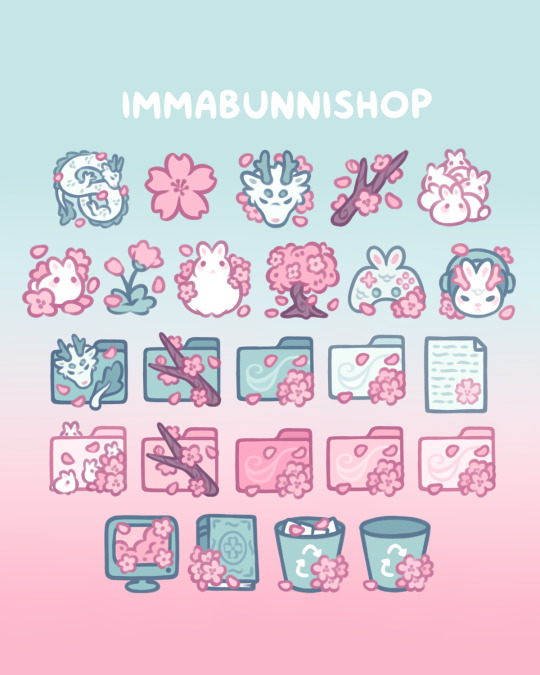
the icons from my newest desktop theme 🌸🐉🌸🐇🌸
available here ♡
#notion stuff#these are so cute and I can think of so many notion pages they would look adorable on 🌸✨🌸
43 notes
·
View notes
Text
Oh my gosh. I just found this website that walks you though creating a believable society. It breaks each facet down into individual questions and makes it so simple! It seems really helpful for worldbuilding!
128K notes
·
View notes
Text
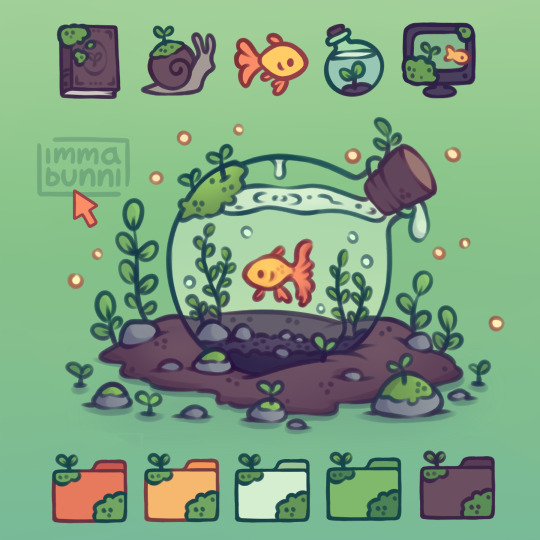
A little pond in a bottle 🫧🌱🐟💛🧡
from my shop
5 notes
·
View notes
Text
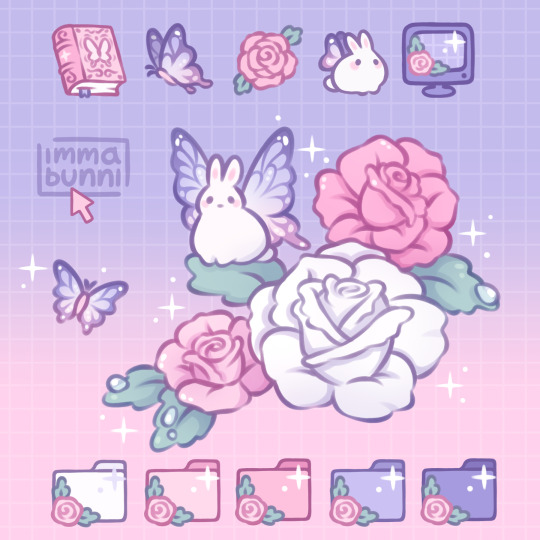
Bunnerflies! ₊₍ ᐢ..ᐢ₎/ ʚїɞ⊹₊˚⊹♡✧ʚїɞ
*insert barbie fairy magical music* hu hua hua hauu
from my shop
3 notes
·
View notes
Text
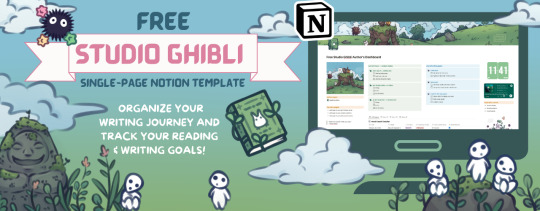
I just released a FREE version of my Studio Ghibli Author's Dashboard Notion Template!
This is a single-page author's dashboard with space to organize your writing goals across all projects, track word count, and record writing inspiration and story ideas. Just like my full Studio Ghibli Author's Dashboard, this template features adorable Studio Ghibli art & icons in collaboration with @imma-bunni
Find the template on my Gumroad shop through the link below! (or my Kofi shop here) ^^
#notion#notion setup#notion template#notion aesthetic#notion stuff#free notion template#studio ghibli notion template#studio ghibli#my neighbor totoro#studio ghibli aesthetic#studio ghibli totoro#studio ghibli icons#spirited away#ghibli#my stuff#writblr#writers on tumblr#writerscommunity
12 notes
·
View notes
Text
The Three Paragraphs That Sell Your Book (No Matter How You Publish It)

by Elijah J Mears
It is a truth universally acknowledged that an unpublished writer in possession of a good manuscript would rather peel off their own skin than market that manuscript. But alas, no matter how you plan to publish—whether you’re going for the long slog in the querying trenches or the lonely shout into the void of self-pub—if a book falls in a forest and no one is around to hear it, it does not, in fact, make a sale.
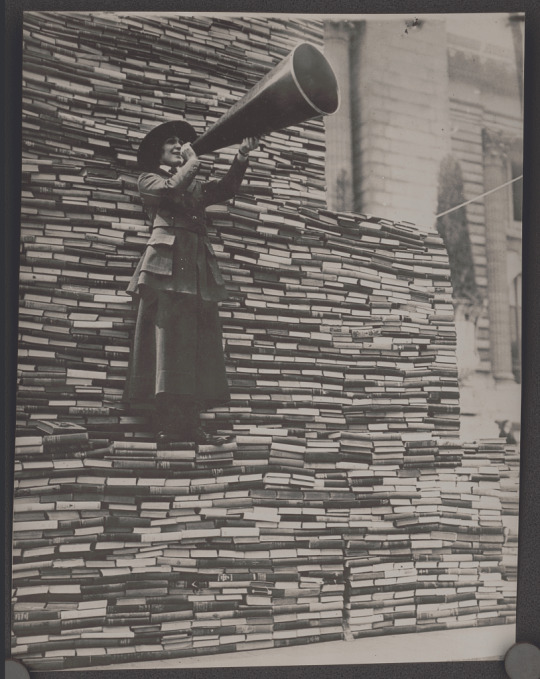
We’ve all been there. I’m there right now. As I wrap up what I hope will be one of the final pre-querying drafts of my own first novel, I’m also staring down the barrel of (gulp) submitting to the mortifying ordeal of being known.
For a long time, I hemmed and hawed over just how I wanted to go. I’ve got a lot of friends in the indie publishing space who’ve tempted my inner perfectionist with the promise of total control and freedom from the whims of agents and publishing houses. On the other hand, even though traditional publishing has changed a lot in the last few decades, it can still be hard to beat having the muscle of a Big Five imprint behind your book, assuming you can get it.
(And I mean, what speculative fiction novelist doesn’t fall asleep at night dreaming of a big fat publishing deal at Tor?)
No matter what path you choose for your novel, your best ally on the path to success is knowledge. But learning things once, frankly, isn’t enough in our industry. Publishing is constantly in flux—what worked well five years ago could be disastrous today. Any wisdom I could give you in this blog post might be dangerously out of date a month from now.
So instead, I want to share some of my teachers with you. These are voices I’ve come to trust during my own writing journey. Even if the specific resources I’m linking to end up going out of date, I know I can count on these fine folks to think fast, adapt, and steer me in the right direction.
These are the people I know you can trust to teach you about the most critical piece of copy you’ll need in your marketing arsenal, no matter which route you take.
That’s right. I’m talking about your book blurb. I mean pitch. Or, uh, your hook. Premise?
Maybe we should start by defining some terms.
Premises, book blurbs, and pitches: oh my!
If you’ve ever looked up how to write a back cover blurb or how to write a query letter, you’ve probably encountered a myriad of terms for what is fundamentally the same concept.
On the indie side of the table, I almost always see these three paragraphs called your “book blurb.” Although occasionally I see the less ceremonious moniker of “back cover copy.” This can still get confusing because traditional publishing often uses the word “blurb” to mean something else entirely. But my friends pretty universally use that word for these three paragraphs. If you self-publish, you’ll use this pitch on your back cover, your sales page on Amazon or Kobo or Itch or wherever else you sell, and basically anywhere you’re trying to convince someone to exchange money for a copy of your book.
For traditional publishing, we get a little messier. I like the word “pitch” for this piece of copy, mostly because it’s the word I first saw someone else use for it, and I’m sentimental like that. Nostalgia aside, there’s really no standard here—I’ve seen it called a hook, a story premise, a book description, and probably a few other things. But all these words mean the same thing: the three-ish paragraphs of your query letter where you try to get an agent to jump up and shout, “That sounds amazing! I simply must read it and sell it to a publishing house for a bajillion dollars.”
And while back cover blurbs and query pitches might appear in slightly different places, what I’ve come to realize as I’ve researched how to write them is… they’re basically the same thing.

What all these terms boil down to is this: if you’re going to get someone sufficiently invested in your book to either buy a copy or offer you representation, publishing as an industry has decided that the best way to do this is to condense your story down to a 200-300 word pitch that sets the scene, introduces your protagonist, their stakes and the conflict they’ll face, and leaves your audience with an understanding of why your novel is going to rock their world. Generally, this shakes out over three-ish paragraphs. Although, especially with your back cover copy for self-published books, you have some wiggle room.
Crucially, your blurb or pitch is not your synopsis, which covers the whole book. The key here, whether you’re putting your ebook together yourself in Vellum or tearing your hair out combing through QueryTracker, is that these three paragraphs really only cover the first 25% or so of your book. Their job isn’t to explain your entire plot. It’s just to convince an agent or prospective reader that yes, if they put in the time to read your novel, this is the way it’ll make them care and suck them in.
That said, there are some differences between the pitch and the synopsis. That’s where it’s really useful to have trusted resources you can rely on to teach you the basics and then keep going. So, without further adieu, let me introduce you to some of my trusted mentors on the hero’s journey of publishing.
Jessie Cuniffe of Book Blurb Magic
If there’s one person I can think of who knows a thing or two about writing indie book blurbs, it’s Jessie Cuniffe over at Book Blurb Magic. She’s written literally hundreds of blurbs and has boiled back cover copy down to an art and a science. What I love about Jessie’s resources is that, while she’s definitely running a business over at BBM and isn’t afraid to make a sales pitch for her services, she’s still very invested in teaching and empowering people to write blurbs on their own.
I happen to have taken her course on the subject (and can absolutely recommend it). But frankly, I’ve learned nearly as much just by paying attention to her social media and her newsletter. She emails more or less daily, and while there may be a sales pitch at the end, each one also contains valuable knowledge about the art of the blurb.
The other thing that’s really valuable about Jessie is that, because Jessie writes back cover copy for a living, she stays well on top of the pulse of an ever changing industry. In addition to general advice on blurb-writing, I can always count on her newsletter and socials to keep me apprised of what’s current and upcoming, like the rise of first person blurbs in the romance genre, or the trend toward shorter, more efficient blurbs as people’s attention spans shrink and our time becomes more precious.
You can find Jessie dispensing knowledge and hot takes over on her Threads account. I can also recommend signing up for her newsletter, which includes a free “Anatomy of a Book Blurb” cheat sheet.
Lewis Jorstad of The Novel Smithy
So, a very short story: when I first decided I wanted to get serious about finally writing a novel like I’d always said I wanted to (this was the middle of COVID, everyone was doing it), Lewis’ blog over at The Novel Smithy was the first resource I stumbled across when I asked Google, “Ok, how do I do that?” Honestly, his blog is full of lots of advice on the entire writing process, but for our purposes, I want to especially highlight his excellent post on how to write a back cover blurb.
The reason I like this resource so much—and, frankly, all of Lewis’ resources— is because it’s so darn simple. Lewis is an excellent teacher who is great at explaining difficult concepts in ways that make my brain go, “Oh, of course! Why didn’t I realize it was that simple?” Plus, he always provides strong real-world examples of the concepts he’s explaining so that it’s easy to see how craft concepts apply to reality.
Alyssa Matesic on YouTube

Let’s dive headfirst into our first resource focused more on the querying side of things than on back cover copy. Alyssa Matesic is a publishing industry professional and developmental editor who has handled hundreds of queries during her time in the publishing industry. I’m a huge fan of her free forty-minute query letter course on YouTube (as well as her other videos), which I watched and then immediately ran to strengthen my own draft query of my work-in-progress novel. While the video is meant to cover the entire query, it focuses mainly on the pitch section because the pitch takes up so much of any query’s word count.
Something I thought was really strong about this video course was that a significant chunk of its runtime is spent walking through several different versions of a query for the same book. I thought this was really helpful for looking at my own pitch and identifying possible areas of weakness because Alyssa’s video didn’t just show several examples of weak pitches. It also shows how you can improve on the weaknesses in your pitch over successive drafts.
Janet Reid of Query Shark
This is the odd one out of my resources because, unfortunately, Janet Reid (may her memory be a blessing) passed away last year. Unlike the other teachers on this list, as publishing continues to change, her website won’t be able to keep up with the times. That said, over the years, Query Shark published and evaluated hundreds of query letters. And it’s still hands down the best resource I know for getting the gist of how queries work, including the pitch section.
Janet spent more than twenty years as a literary agent in New York, and Query Shark was one of many ways she gave back to the publishing community. Combing through her archives, you’ll find hundreds and hundreds of query letters with Janet’s editorial feedback on what is or isn’t working. Even as publishing changes, I suspect the fundamentals of what makes a good query letter will remain mostly the same, and many of Janet’s query critiques focused on helping authors get their story onto the page.
If you’re anything like me, you’ll lose hours reading through Janet’s archives. But you’ll come out the other side with a much clearer sense of what it is that really makes a standout query, especially how to write a pitch that can sell your book.
Find Janet’s pearls of wisdom (and snark) at QueryShark.blogspot.com.
Jane Friedman of, well, she’s Jane Friedman
Last but absolutely not least, is Jane Friedman. The former President and CEO of HarperCollins has basically made her name synonymous with keeping up with what’s happening in the publishing industry. Best practices for pitches, queries, back cover copy, and everything else is absolutely included with that. I could probably write several articles just about the different resources she has available. But thankfully, she’s compiled her best stuff into one friendly resource hub that you should absolutely check out.
The most useful things here for those of us who are learning about pitches (Jane uses “story premise” and “hook” for these—as I said, this industry is terrible about consistent terminology) are the story premise and hook problems pages. She also has an entire category on her blog for queries and synopses that is well worth a read. There are ample resources on self-publishing as well, including a guest post on back cover copy that—even if it never quite says it explicitly—does a good job of showcasing that your query pitch and your back cover blurb are very, very similar things.
These teachers have done wonders for me. As I get ready to start querying my own novel, I know that my pitch will be stronger because of having their advice and wisdom. If things change down the road, and I decide that self-publishing is ultimately the right path… I’ll be able to take that leap knowing that one of my most important pieces of marketing copy is basically already written. So I hope that, whatever publishing path you choose to take, these resources will help you to feel empowered and ready to take on the next step in your writing journey with confidence.
Source: The Three Paragraphs That Sell Your Book (No Matter How You Publish It)
424 notes
·
View notes
Text
✍ NOMADIC WORD OF THE DAY
-----------------------------
Lurid (Adjective)
"Causing horror or revulsion. Shocking. Gruesome."
-----------------------------
Use today’s word in a sentence, a short scene, or even a mini dialogue! What is lurid in your world? I would love to see!
26 notes
·
View notes
Text
Notion is the answer!!
It's like making a webpage for your wips but you don't have to code anything (!) And it's free (!)
It combines note-taking, databases, calendars, and to-do lists. You can build exactly what you need—a writing hub, a plotting database, a journal, or a complex project tracker. You can add text and images and playlists and videos, embed pages within pages, and make custom databases for all sorts of things. It's rather great, really (i am biased)
The only shortcoming with Notion is that you start with a blank canvas, and have to build everything yourself. The learning curve can be steep, so I suggest you find some templates to start with.
Talking of which, may i interest you in:


A dark academia project template


The same but in a different font, and a bit neater


A master page, a writing hub where you can develop multiple books at once
(Did you notice I made a gradient?)
46 notes
·
View notes
Text
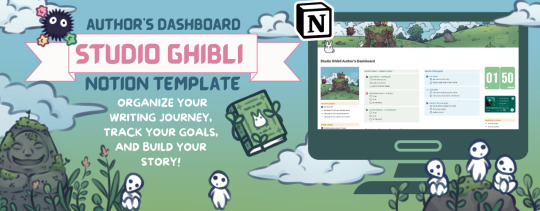
I partnered with @imma-bunni to make this Studio Ghibli Author's Dashboard Notion Template using some of the gorgeous art and icons from her Studio Ghibli Desktop Set. The art and icons make the template so adorably aesthetic and cute and I'm so proud of how it turned out!
It has space for goals, inspiration, word-count tracking and story idea banks as well as author pages to record income/expenses, a reading library, and publishing submission tracker, AND a story page with databases to fill in worldbuilding, character, and plot info. You can find it in both my Etsy and Gumroad shops.
#notion template#my stuff#notion#notion setup#notion aesthetic#notion stuff#studio ghibli notion template#studio ghibli#studio ghibli aesthetic#my neighbor totoro#spirited away#ghibli aesthetic#soot sprite#princess mononoke#castle in the sky#writeblr#writing community#writers on tumblr#notion icons#notion art
9 notes
·
View notes
Text
hey if you're the type of writer that's like me where you tend to write specific scenes first that vaguely weave together into a plot, you might like using obsidian as a writing app.
my frustration with other writing applications is that i will write my scenes out of order and it's hard to move things around and rearrange them on a regular document.
but with obsidian there's this canvas feature where you can just write all your scenes and plot moments on these little cards that you can freely rearrange. you can color code them and connect them too.
here's the canvas i've created for my current multi-chapter fic: (if you zoom in you can see all the text in each card this what it looks like zoomed out)

as you can see, i color code them based off chapters and will group them next to a document card with the working title of the chapter. anything not color-coded are scenes that don't have a proper place quite yet or it's just world building references. this app can also be good for note-taking and collecting research!
best of all, it's FREE!!! the only downside is that if you want your stuff to sync across devices, you do have to pay for that. i constantly hop between my laptop and desktop so i pay for the syncing. but if you write on only one device it's completely free! EDIT: some reblogs have mentioned that you can apparently link your own personal cloud storage (dropbox, gdrive, icloud, etc.) to obsidian for free! that way you can access your obsidian vaults across multiple devices without the extra fee. i don't mind supporting the devs but just something to look into if costs is a concern.
i typically use it for organizing my thoughts for a first draft. once i get all the scenes arranged and mostly written out, i will copy and paste them into ellipsus (also free & highly recommended as a google doc alternative) so that they're all in one document that i can edit.
5K notes
·
View notes
Text
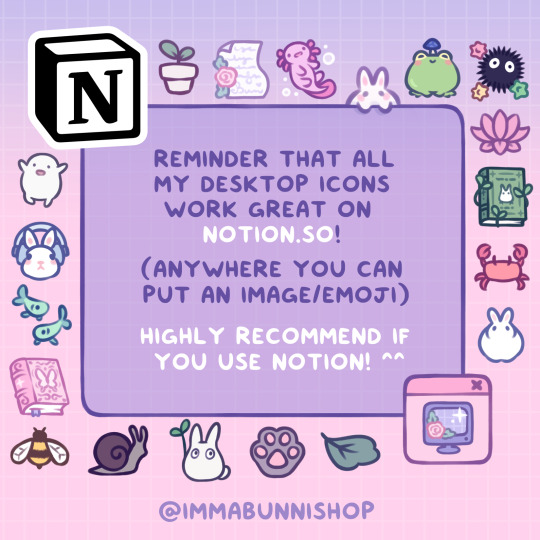
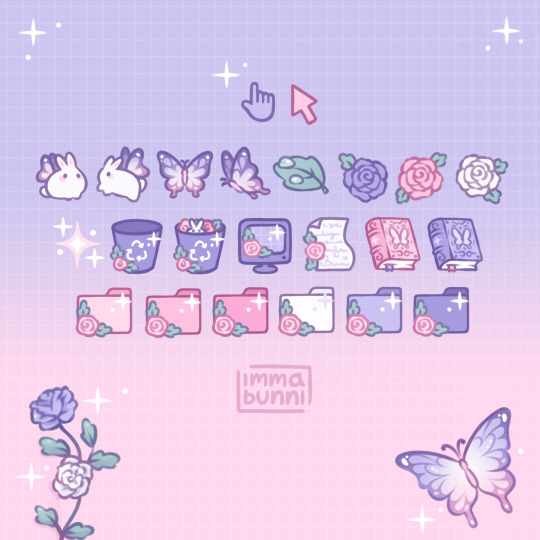
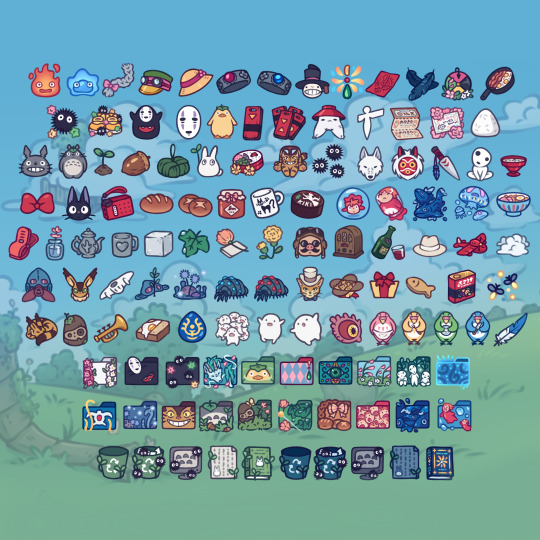

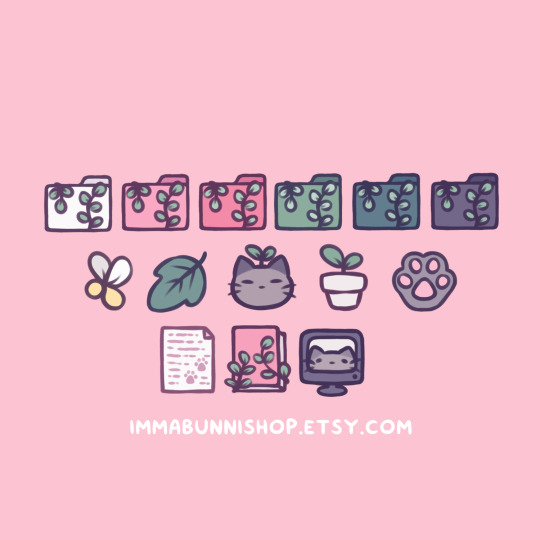
...and more in my shops! ♡ (and also some freebies on ko-fi/gumroad ;)
(ko-fi has every set, gumroad has ghibli, and etsy has everything BUT ghibli!)
I use these on my own notion all the time - it's amazing - definitely recommend! ✨👍🩷
#notion stuff#these are so cute I have all of them and use them for every Notion page!!#my personal favorite is the ghibli set but they’re all just so adorable
12 notes
·
View notes
Text
Writing with Colors

A list of resources to help you describe different colors in your writing.
The Color Thesaurus A collection of infographics that show various shades of different colors, each shade/color labeled by name.
Color Reference Chart Another collection of infographics that show various shades of different colors, each shade/color labeled by name.
Hair Color Reference Chart A collection of infographics that show various shades of different hair colors, each shade/color labeled by name.
Eye Color Reference Chart A collection of infographics that show various shades of blue, brown, and green eye colors, each shade/color labeled by name.
Different Ways to Describe Hazel Eyes A list of ideas and suggestions for describing hazel eyes. Can be used as prompts or for brainstorming.
Different Ways to Describe Green Eyes A list of ideas and suggestions for describing green eyes. Can be used as prompts or for brainstorming.
Different Ways to Describe Blue Eyes A list of ideas and suggestions for describing blue eyes. Can be used as prompts or for brainstorming.
Different Ways to Describe Brown Eyes A list of ideas and suggestions for describing brown eyes. Can be used as prompts or for brainstorming.
+
I’m a writer, poet, and editor. I share writing resources that I’ve collected over the years and found helpful for my own writing. If you like my blog, follow me for more resources! ♡
7K notes
·
View notes